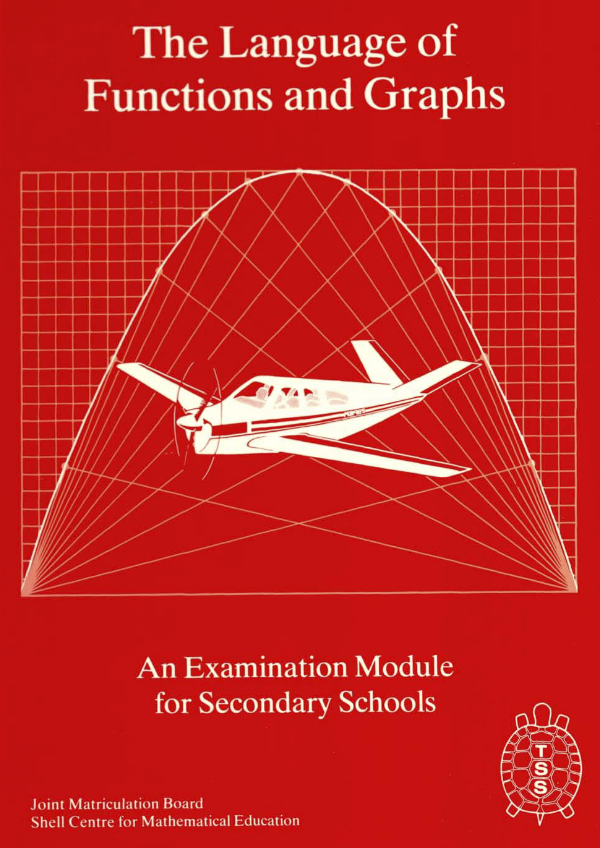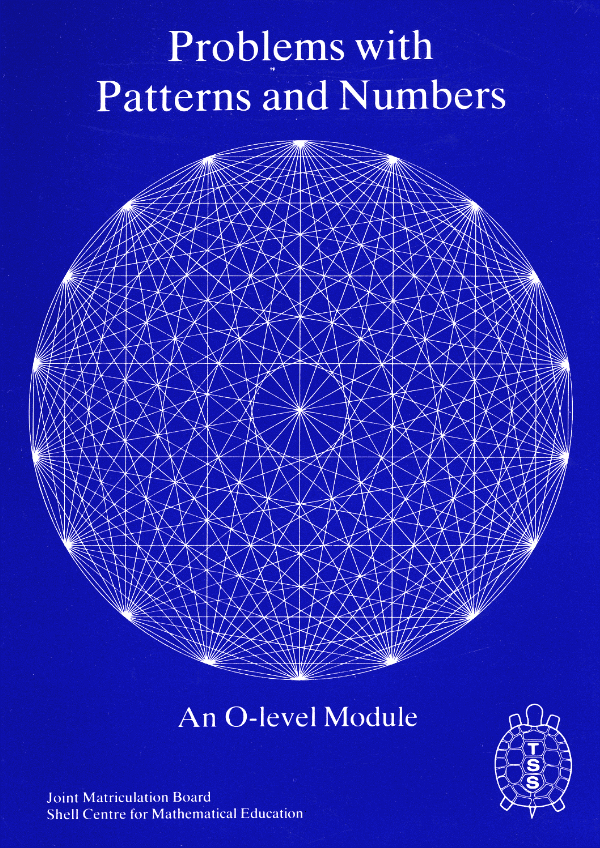30 Design Strategies and Tactics from 40 Years of Investigation
Shell Centre for Mathematical Education


Abstract
This paper discusses some of the design approaches used in 40 years of work at the Shell Centre for Mathematical Education – and some examples from other groups – for which there is some evidence of efficacy. These range from detailed tactics for designing student activities to more “political” strategies for fostering change at system level. The paper is structured as a short overview listing and summarizing the strategies, each of which links to a page containing more details, examples and – where possible – onward links to the actual materials.
Provenance
The Shell Centre for Mathematical Education was founded in 1967, largely as a result of the efforts of the Professors of Pure and Applied Mathematics in the University of Nottingham. Some mathematicians at that time believed that the keys to improvement were a deeper understanding of the subject by teachers and a focus on these fundamentals in teaching. So initially the Centre mainly provided professional development workshops for teachers in the region. When Hugh Burkhardt arrived as Director of the Shell Centre, far from convinced that we really knew how best to help teachers teach better mathematics more effectively, he decided to adopt a broader, research and development brief. The vision was, and is, to focus on research, design and development that will have direct impact on what happens in school classrooms. The small team of permanent staff meant that large-scale influence can only be achieved through reproducible materials that support more effective teaching. This suggested an important role in our work for imaginative lesson design, based on research-in-depth, that would avoid the imitative procedural nature of the ‘demonstrate and practice’ teaching and learning, observed in most mathematics classrooms. The Centre has been able, over a long period, to attract exceptionally talented designers of educational materials - notably our late friend and colleague Malcolm Swan, with his genius for the design of learning activities.
From time to time we have analyzed the design strategies, tactics and techniques that have proved effective and written some of them up in journal articles (see, e.g, Burkhardt 1981, Bell 1993, Swan 2006, Burkhardt and Swan 2014, 2017). This article arose from a talk in Hong Kong launching the 2019 conference of the International Community for the Teaching of Modelling and Applications (ICTMA- 19). The talk focused on the sequence of Shell Centre projects and the gradual abstraction of design principles from them. It then seemed useful to organize these into a catalogue, presented at ISDDE 2019. This article adds brief explanations and, most important, links to illustrative examples from various projects from the Shell Centre and elsewhere.
These elements of design have been developed mainly with teachers and students aged 7 to 18, working in school and college classrooms settings, along with associated assessment and professional development. Nonetheless, we believe some of them are more broadly relevant. We hope the collection may prove interesting, even useful, to readers of Educational Designer, particularly those who design tools for others to use. Comments and suggestions for other entries are invited.
Some strategies are ‘hard sells’, often for political reasons (Burkhardt 2019). For example, politicians often see examinations as ‘measuring for accountability’, with little concern for what is measured and its effect on classroom practice. So it pays to work with policy makers as well as practitioners, whenever you can (Burkhardt 2019). Focus on ‘their’ problems, offering insight and modest step-wise win-win solutions even when they, as so often, want to ‘fix the problem’.
Levels of design
It is useful to distinguish (Burkhardt, 2009):
Strategic design focuses on the design implications of the interactions of products with the system they aim to serve.
Many otherwise excellent innovations fail because of the neglect of strategic design questions including: What kind of users (often teachers) is this designed for and developed with? What changes does it require in their current practice? Is adequate support provided, within the materials or otherwise? Above all: Why should they change? Are the reasons among their day-by-day priorities?
Tactical design focuses on structures within the materials that help teachers achieve learning activities that effectively forward student thinking.
This raises parallel issues and questions: What demands of professional expertise and time does using this tool make on the target user initially, then after using it several times? Does the tool provide effective support for this transition? Is there enough detailed support and guidance for users in the target group? Is there so much that many won't read it?
Detailed design focuses on helping the typical user to achieve high-quality realisation of the learning goals – for example, a typical teacher to handle a powerful learning activity sequence that they can enhance from their own talents and experience. It is here that creativity can inject magic into learning – in design the details matter. Here there are two overriding questions:
- Does the design set out an activity sequence that works well with students in forwarding the intended learning goals?
- Does the design communicate with target users so that they can realise with their students a variant on the activity sequence that is compatible with the design goals?
An iterative program of trials, with rich and detailed feedback guiding revisions, should provide the answers to these questions.
While detailed design is not the focus of this article, it is perhaps the most important factor in design of all materials for learning since the quality of the tasks that students work on sets an upper limit on what they can learn. Tasks for learning and assessment should be varied and rich enough to require thinking – not just remembering – and constructing chains of reasoning based on recognising connections within mathematics and to a range of contexts in the wider world. The many and varied tasks in the links below have been chosen to exemplify high quality.
Design strategies
Note: Online materials
This printable document only contains the overview – more complete descriptions of each strategy and tactic, with examples and links to online resources, can be found online - see https://educationaldesigner.org/ed/volume4/issue13/article53/links/ for the index.
- Look for ‘leverage’ points that answer: “Why should they change?” "Is there enough help?"The Shell Centre's Testing Strategic Skills program (1980-88) provides our best realization of these strategies, exemplified by Problems with Patterns and Numbers (‘The Blue Box’) and The Language of Functions and Graphs (‘The Red Box’)

Link to the materials

Link to the materials
Links to materials:
- TSS – The Language of Functions and Graphs
- https://www.mathshell.com/materials.php?series=tss&item=lfg
- TSS – Problems with Patterns and Numbers
- https://www.mathshell.com/materials.php?series=tss&item=ppn
The next 4 entries provide explicit examples of leverage strategies.
-
Gradual change – Plan the pace of change to answer, realistically: How big a change can typical users (often teachers) carry through successfully each year – given the support provided?
This obviously sensible constraint is usually ignored by policy makers who like to "solve the problem of...." in education in a way they never would in, say, medicine where gradual progress based on research, design and development is the accepted norm.
More with examples… -
WYTIWYG – High-stakes examinations are powerful levers, for better or, usually, for worse - What You Test Is What You Get in most classrooms. So work to turn the exams into “exams worth teaching to”.
Current tests in many school systems impoverish the teaching of mathematics in classrooms by including only a narrow subset of the range of task types needed in learning and doing mathematics. Substantial chains of reasoning by students and non-routine problem solving become expendable luxuries.
More with examples… -
Alignment – Avoid mixed signals. Harmonize and link: policy documents, examinations, curriculum materials, and professional development.
Another obvious strategy that is rarely taken on board by reforming school systems, particularly but not only decentralized ones where the ‘noise’ of diverse pressures undermines any efforts at alignment. Incremental changes make coherence and alignment easier.
More with examples… -
Think of longer timescales for learning – from the single lesson to the unit/module and beyond.
Learning is a lengthy process of building robust connections to what you already know, understand and can do.
More with examples… -
Take a constructivist approach to professional development – Professional development, like all learning, should be activity-based, with teachers learning primarily by reflecting on high-quality student learning activities in their own classrooms. See ‘The sandwich model’ under ‘Design tactics’ below.
-
Materials-based professional development can increase the power of session-based PD, providing it is designed and developed through iterative trialling – as high-quality products are in other fields.
While it is widely accepted that most teachers and their students can benefit from using well-engineered teaching materials, the same is not yet true for professional development; most PD leaders design their own sessions. Yet designing excellent activity sequences for teachers' professional development is at least as challenging as designing lessons. As ever feedback determines structures: most evaluation of PD is based on participant teachers' perceptions of the session – not on the resultant changes in their classroom practice. Where such changes have been studied it has led to profound redesign of PD.
More with examples… -
Use engineering methods – ‘Fail fast, fail often.’ Use rapid prototyping, small-scale trials, rich feedback, iteration – all are central to success in combining educational ambition with robustness in use.
This standard approach from other fields of R&D comprises successively: knowledge of prior research and products; imaginative design of drafts/prototypes; iterative refinement through trials in increasingly realistic circumstances, with rich and detailed feedback to provide evidence for revisions. Direct observation using structured reporting is key – expensive but invaluable.
More with examples… -
Identify target groups – including teachers. Who do we need this to work for? Just the enthusiasts? Typical teachers in supportive environments? Every teacher?
In any skilled field the range of performance among practitioners will be wide. The chosen target group needs well-engineered support. Though initial trials of a design will usually be by the design team, then by ‘robust’ teachers, final trials need to be with users representative of the target group.
More with examples… -
Replacement units – Materials to support a few weeks innovative teaching can lead to deep-but-gradual changes that are digestible, particularly for the teacher.
The units must justify the teachers' extra effort by adding something that is both new and important, explaining the rationale and providing enough support to enable teachers in the target group to implement the lessons in their classrooms.
More with examples… -
The Box Model takes this further, exemplifying complete alignment in a single package of materials.
This package contains test task exemplars for a high-stakes examination + teaching materials + materials to guide teachers' do-it-yourself professional development in their school. All the elements were designed by the same team. It adds WYTIWYG to replacement units.
More with examples… -
Investigative app-based microworlds can stimulate higher-level thinking, role-shifting and student/pair autonomy.
You can make the computer a personality in the classroom that takes over key task-setting and information providing from the teacher, who is freed to adopt the non-directive counselling roles that really support the development of problem solving skills.
More with examples…
Design tactics
For teaching materials
-
Focus on what the students are doing at every point, asking whether it is intellectually worthwhile and provides an appropriate cognitive demand – productive struggle - for all students at all levels.
In observing teaching there is a natural tendency to focus on what the teacher is doing, even though student learning is the objective and high quality learning activities can be supported by superficially different teaching styles. The link exemplifies this with a professional development activity for observers based on the 5 dimensions of TRU - Teaching for Robust Understanding.
More with examples… -
Control the ‘design load’ on teachers –Offer detailed guidance when you are better placed to advise than the user to devise what to do – but not more than many users will read, or turn to in need.
How much guidance shall we give teacher-users of our materials? Some sophisticated teachers feel it is disrespectful to offer detailed guidance ‘to fellow professionals’ on a good way to handle the sequence of student activities in a lesson; indeed some would just present rich tasks, giving teachers only general guidance on pedagogy. However, teachers in trials always ask for more detailed guidance. Too much and, of course, they won't read it – a classical design trade-off.
More with examples… -
Exemplars communicate vividly – whether task sets, student work, lesson segments or PD video.
Descriptions tend to be interpreted within prior experience: “Oh yes. I know what you mean.” Accompanying examples reduce the chance of misinterpretation. It usually works better to have the example first – followed by the explanation of the general point.
More with examples… -
Devise vivid representations – Tasks are usually more comprehensible when supported by pictures, diagrams or video.
Equally students need to learn to devise representations to help them understand problems.
More with examples… -
Design for ‘role-shifting’ – Moving students into higher-level roles is powerful in developing a student-centered ‘classroom contract’ that promotes powerful learning.
Lessons that ask students to analyze a problem, critically review an argument, make recommendations as a consultant, and explain their findings to a client (not their teacher) reinforce their ability to ‘do mathematics’.
More with examples… -
Vary lesson styles – Most students find school mathematics boring - sympathize with them in your design by including a variety of lesson genres.
In English (or native language) classes there is a rich variety of types of lesson including reading or writing plays or poems, constructing persuasive arguments, critiquing texts including their own or their fellow-students in, for example, ‘Writing workshops’ – a well-defined routine of drafting and peer-commenting that enables students to develop sketch ideas into substantial stories. Similar variety is needed for STEM subjects.
More with examples… -
Design lessons as dramas – Every classroom is a theatre. Use that fact in lesson design, but make the teacher the director not the star.
‘Maths is boring’ to most students. Unlike some other subjects, mathematics lessons rarely have dramatic tension, or surprise – except over scores. Usually, the math teacher is the director and the star. The students are the audience. The play begins with a long soliloquy – then it’s over! Students just imitate what they have been shown, many times over. The drama design approach increases student motivation and problem solving in a broad sense.
More with examples… -
‘Common issues’ tables help teachers to recognize misconceptions, then to choose appropriate interventions that help students forward their reasoning without undermining their ‘ownership’ of the solution process. Equally, for problem solving tasks the tables help the teacher facilitate the active process of problem solving without undermining student autonomy.
More with examples… -
‘Student work’ examples for critiquing can be designed to shows alternative approaches, stimulate analytical thinking and role shifting. This device also lets you show more advanced methods that are unlikely to arise in most classes (thus pre-empting the "mathematics is not up to grade" criticism of problems where the main demand is strategic).
More with examples… -
Process-focused lessons with an explicit focus on, for example, modeling processes, can provide metacognitive support to help students transfer higher-level skills to other problems.
More with examples… -
Student guides supporting extended non-routine (modeling) project work
Worksheets are familiar examples of materials-guided student work on the timescale of a lesson or two. Less familiar is the concept of using the approach to guide extended non-routine small-group project work. Because the teacher can mostly observe, only intervening where necessary, this approach has the advantage of emphasising student agency, ownership and responsibility for what the group produces.
More with examples…
For professional development materials
-
‘The Sandwich Model’ and other tactics for materials-guided professional development are designed to help teachers generalize important aspects of pedagogy and student learning from high-quality experiences in their own classrooms – social constructivism. A sequence of such modules, each focussed on an important aspect of pedagogy that may be outside a teacher's prior experience, provides an important start in working towards membership of an ongoing professional learning community (PLC)
In this model each module is based on three sessions, a week or two apart, with all information and guidance in handouts:
- structured teacher-group discussion of the target issue, with lesson preparation
- each participant teaches that lesson in their class
- structured group consideration of what has been learned
For assessment materials
-
The ‘exponential ramp’ – Tasks that offer increasing challenges and opportunities – in complexity, generality, and abstraction within the same core task – support access for all students to rich tasks.
More with examples… -
A challenge in designing non-routine problems, particularly for high-stakes situations, is to know how far from each student's social and mathematical experience the problem is – the transfer distance. The next two examples are methods of handling this through giving students a known prior experience. (Guidance to teachers on how intensively to prepare the students may, or may not be followed if the examination is high-stakes.)
-
Exams on projects, provide assessment with a controlled ‘ramp’ of transfer-distance
If all students have worked on a specific project for a significant period, examination tasks can be designed to be relatively close to, or more distant from, the tasks in the project. Collectively these can provide a ‘ramp’ of increasing ‘non-routineness’.
More with examples… -
Modeling exams with advance background reading
This enables the designer to control the ‘transfer distance’ for modelling tasks, making them less dependent on other specific curriculum activities. Giving teachers and their students a few pages of background reading about specific contexts gives the task designers a base of common knowledge to work from.
More with examples… -
Task materials for ‘coursework’/portfolio assessment improve validity and ease comparability.
‘Portfolio’ (US) or ‘coursework’ (UK) assessment is capable of higher validity than is possible in timed-written examination, being closer to real world problem-solving situations. In some systems each student with their teacher is free to choose the task(s) but this presents problems – of task richness and difficulty, and of comparability. Mandating each year a specific set of tasks from which to choose can mitigate this problem, particularly if the tasks have been trialled and their difficulty established.
More with examples… -
Appropriate uses of computer and paper in assessment can restore validity, inevitably lost in purely computer-based testing in STEM subjects.
Computer-based testing (CBT) is often seen by policy makers as the ‘Philosopher's Stone’ of assessment – it seems to be inexpensive, with no danger of human bias and instantly available results. Currently it falls short on all these properties for a variety of non-trivial reasons. We will focus on the most profound. Of the six main steps in testing, computers are excellent for three: presenting a task; recording scores; processing scores into ‘results’ for diverse users. Computers are terrible at the other three steps, for non-routine tasks in STEM subjects at least: providing a natural working medium for mathematical and scientific investigation and reasoning; interpreting student reasoning, particularly sketch diagrams and symbols; evaluating substantial responses to produce scores. As always, it is best to use technology for what it does well – in this case, assessing short ‘items’ and handling data for all tasks. For most complex tasks involving substantial chains of student reasoning, paper is still the best working medium and scoring of responses needs the trained human mind; technology can help by scanning student responses and presenting them to scorers on screen, and recording each score point.
More with examples…
Acknowledgement
Enormous thanks to the many people with whom these strategies and tactics have been developed - and, of course, to fine designers who have used them so powerfully.
References
Bell, A. (1993). Some experiments in diagnostic teaching. Educational Studies in Mathematics, 24, 115-137.
Burkhardt, H. (1981). The Real World and Mathematics, Glasgow: Blackie, reissued Nottingham: Shell Centre Publications 2000.
Burkhardt, H. (2009) On Strategic Design. Educational Designer, 1(3). Retrieved from: http://www.educationaldesigner.org/ed/volume1/issue3/article9.
Burkhardt, H., & Swan, M. (2017). Design and development for large-scale improvement. Emma Castelnuovo Award lecture in G. Kaiser (Ed.) Proceedings of the 13th International Congress on Mathematical Education, pp 177-200. Cham: Springer International Publishing
Burkhardt, H. (2019) Improving Policy and Practice. Educational Designer, 3(12). Retrieved from: http://www.educationaldesigner.org/ed/volume3/issue12/article46/
Swan, M. (2006). Collaborative Learning in Mathematics: A Challenge to our Beliefs and Practices. London: National Institute for Advanced and Continuing Education (NIACE) for the National Research and Development Centre for Adult Literacy and Numeracy (NRDC).
Swan, M., Burkhardt, H. (2014) Lesson Design for Formative Assessment. Educational Designer, 2(7). Retrieved from: http://www.educationaldesigner.org/ed/volume2/issue7/article24/
Additional references can be found in the individual ‘More…’ sections. We have only provded formal references for academic articles and books – there are many other links to materials on the web.